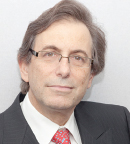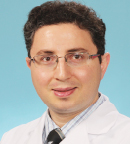Using a novel approach called tumor-treating fields—which involves the delivery of low-intensity electric fields to the brain by a patient-operated device—along with standard-of-care temozolomide therapy improved overall survival and progression-free survival vs temozolomide alone in patients with glioblastoma, according to the final results of a phase III trial presented at the 2017 American Association for Cancer Research (AACR) Annual Meeting.1 Patients treated with tumor-treating fields plus temozolomide had a 37% reduced risk of death compared with those randomized to receive temozolomide alone.
Magnitude of Benefit
Median overall survival with tumor-treating fields plus temozolomide was 20.9 months vs 16 months with temozolomide alone, representing a highly statistically significant (hazard ratio = 0.63; 95% confidence interval = 0.53–0.76; P = .00006), 5-month absolute difference in this highly aggressive, uniformly fatal type of brain cancer. At 2 years, overall survival was 43.1% vs 30.7%, respectively.

[Tumor-treating fields] is a novel treatment modality to add to surgery, radiation, chemotherapy, targeted therapy, and immune checkpoint inhibitors.… It should be offered to all newly diagnosed patients with glioblastoma.— Roger Stupp, MD
Tweet this quote
“This is the same magnitude of benefit over current treatment that we saw when first-line temozolomide was introduced over 10 years ago. [Tumor-treating fields therapy] provides an additional benefit in combination with temozolomide. We still need to achieve further improvement, but this is a substantial step forward with a unique ‘out-of-the-box’ type of therapy,” said lead author Roger Stupp, MD, Professor of Neurologic Surgery, Neurology, and Oncology at the Feinberg School of Medicine, Northwestern University, Chicago.
“The last time any form of treatment was shown to improve survival for patients with this disease was more than 10 years ago, when adding temozolomide to radiotherapy was shown to improve the 2-year survival rate from 10% to 27%,” he told listeners.
“Tumor-treating fields should be offered as part of standard therapy to every newly diagnosed patient with glioblastoma,” Dr. Stupp stated.
Study Background
Glioblastoma is the most aggressive deadly brain tumor. It arises in the brain and does not metastasize, making it a good disease to study a locoregional treatment like tumor-treating fields. Twenty years ago, median survival was less than 1 year, and very few patients lived for 2 years. With temozolomide, median survival reached 15 to 16 months, with a 2-year survival rate of 27%. With the addition of tumor-treating fields, the median survival is over 20 months, and over 40% of patients are alive at 2 years.
The current standard of care for glioblastoma includes surgery, radiation, and temozolomide chemotherapy. One of the challenges in treating glioblastoma is that most available drugs do not readily penetrate through the blood-brain barrier. “In order to get through to the brain, we need to think outside the box,” he told listeners.
Tumor-treating fields technology uses physical force to affect tumor growth. First developed in Israel by researcher Yoram Palti, Professor Emeritus of Physiology and Biophysics at the Technion Israel Institute of Technology, this innovative therapy exposes tumor cells to an electrical field, which perturbs dividing cells and interferes with the polar tubulins of the mitotic spindle apparatus. This leads to cell-cycle arrest, aneuploidy and ultimately apoptosis, he explained.
Tumor-Treating Fields
- Tumor-treating fields therapy delivers electrical disruption to tumor cells, leading to cell death; the treatment may extend survival in patients with glioblastoma.
- The treatment is delivered by a wearable device that does not interfere with patient activities; it is safe, with the major side effect of skin irritation.
Tumor-treating fields are delivered to the brain continuously by applying alternating electrical fields at an intermediate frequency by a patient-operated, wearable medical device (marketed as Optune). The device is portable (carried in a small backpack or messenger bag) and is attached to 4 patches of 9 electrodes each; these patches are applied to the shaved scalp. One battery charge allows for 4 to 6 hours of treatment, with 4 rechargeable battery packs allowing for independence from an electrical outlet. Patients typically have active therapy for about 18 hours per day continuously. Including the battery, the device weighs slightly less than 2.7 lbs. (1.3 kg). Electrodes are changed every 3 or 4 days.
The learning curve for patients on how to use the device is quick, “often in less than 1 hour,” Dr. Stupp noted. “I’ve had patients on tumor-treating fields who continued going to work and went hiking and skiing.
“Treatment with tumor-treating fields therapy is a permanent chronic or long-term treatment with the ultimate goal of avoiding tumor recurrence or making glioblastoma a chronic disease,” Dr. Stupp told listeners.
After preliminary trials showed the feasibility of this approach, the current randomized trial was mounted in 2009. Following surgery and 6 weeks of radiation with concomitant temozolomide, newly diagnosed patients with no disease progression (n = 625) were randomized in a 2:1 ratio to receive maintenance temozolomide alone for 6 to 12 months vs temozolomide plus tumor-treating fields.
Most of the adverse events reported in the trial were related to temozolomide. The rates of hematologic events, fatigue, and asthenia were similar between the two arms. The only side effect related to tumor-treating fields was skin irritation, which is typically mild. For skin reaction, the treatment is stopped for a few days, and local ointments are applied.
“Over 10 years of studying tumor-treating fields, I’ve seen few patients with major skin reactions. Some patients are on this treatment for 3 or 4 years,” he noted.
Other Key Findings
Median follow-up was 40 months. In addition to the overall survival benefit, progression-free survival was improved in the group treated with tumor-treating fields plus temozolomide. Median progression-free survival was 6.7 vs 4 months, respectively (P = .00005), as patients were randomized only after the end of radiation therapy; for survival from initial diagnosis, another 3 months should be added to all progression-free and overall survival estimates.
A landmark analysis showed improved survival for the combination of tumor-treating fields plus temozolomide vs temozolomide alone at 2 (43% vs 31%, respectively), 3 (26% vs 16%), 4 (20% vs 8%), and 5 years (13% vs 5%) from randomization.
Subgroup analyses indicated the survival benefit is maintained in all patient subgroups. Even poor-prognosis patients with methylated O6-methylguanine–DNA methyltransferase (MGMT)-unmethylated tumors or unresectable tumors and elderly patients equally benefit from tumor-treating fields compared with their counterparts who received temozolomide only.
Two years ago, Dr. Stupp presented a preplanned interim analysis of the first 315 patients enrolled in the trial.2 At that time, the benefit of the combination treatment was evident, and the independent data monitoring committee called for release of the data.
“The hazard ratio has improved over time, but the main message remains the same. The combination of tumor-treating fields plus temozolomide extends survival over temozolomide alone,” he stated. “This provides an additional benefit over temozolomide, but we still need further improvement in this disease.”
Looking Ahead
“This is a novel treatment modality to add to surgery, radiation, chemotherapy, targeted therapy, and immune checkpoint inhibitors. Now we have established tumor-treating fields as a novel treatment modality for cancer,” Dr. Stupp stated.
Future studies will evaluate tumor-treating fields in combination with other drugs, including immunotherapy. Tumor-treating fields is currently being studied in lung cancer, pancreatic cancer, mesothelioma, ovarian cancer, and in patients with malignant ascites, among other indications.3
Dr. Stupp said that neurologists who are unfamiliar with tumor-treating fields have been slow to adopt it. He noted that a common complaint is that patients need to shave their heads to have the electrodes placed. “Patients lose all their hair on chemotherapy, but that is expected and accepted. Some doctors would not even talk to their patients about tumor-treating fields, considering the need to shave their hair not worth it, despite the prolongation in survival,” he said.
The tumor-treating fields device is approved by the U.S. Food and Drug Administration. Many insurance companies will provide reimbursement, said a spokesperson for Novocure, the manufacturer. “Tumor-treating fields is not yet covered by Medicare, but we make sure that every patient who wants tumor-treating fields gets it,” he stated. ■
Disclosure: Dr. Stupp has a consulting or advisory role with Celgene, Ipsen, Novartis, Merck Sharp & Co., and Roche/Genentech (honoraria when applicable to institution) and has received travel assistance in relationship to this study from Novocure. His spouse is employed by and has stock in Celgene.
References



